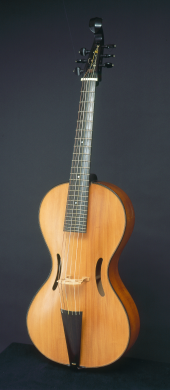Arpeggione Sonata

The Sonata in A for arpeggione and piano , D 821, also known as the arpeggione sonata for short , is a chamber music work for arpeggione and piano by Franz Schubert (1797–1828), written in 1824.
Origin and reception
Franz Schubert's Arpeggione Sonata was written in Vienna in November 1824 (shortly after his second stay in Zelis ) for an instrument that Johann Georg Stauffer had developed in the early 1820s, using names such as “bow guitar” or “guitar-violoncell” “Was run. Schubert's sonata is the only composition in which it is referred to as an "arpeggione". The sonata was probably intended for the instrumentalist Vincenz Schuster , who advocated the new instrument and premiered the work in November 1824 according to the foreword to the first edition published posthumously by JP Gotthard in 1871. This first edition contained one part each for violin and cello , since the arpeggione had already been forgotten by then. Schubert's autograph , which is kept in the Bibliothèque Nationale in Paris, already included a violin part by Anton Diabelli . The pitch of the arpeggione suggested an implementation with the viola . In addition, there are also transcriptions of the melody part for double bass or wind instruments - only a few double stops are notated in the original - such as the flute , treble recorder and clarinet , or even cello with guitar instead of piano.
characterization
The playing time of the work is around 20 minutes. It is divided into three sentences:
- Allegro moderato
- adagio
- Allegretto
The background - probably a commissioned work, and also for a solo instrument that quickly became unusable again - gave the sonata the reputation of a purely secondary or occasional work by Franz Schubert, which however does not do it justice. Konrad Hünteler counts her among the "[...] immortal pearls in the chamber music repertoire [...]". The first, probably the most important movement is in A minor and follows the sonata form . Its main theme is reminiscent of the beginning of the " unfinished ". The short, slow movement (E major) is immediately followed by a rather pleasing, virtuoso rondo finale in A major.
Individual evidence
- ^ Otto E. German: Franz Schubert. Thematic index of his works in chronological order . Bärenreiter, Kassel 1978, ISBN 3-7618-0571-3 , p. 516/517 .
- ↑ Information on Universal Edition
- ^ Foreword to the arrangement of the sonata for flute and piano, Bärenreiter BA 5681, 1995
literature
- Hans-Joachim Hinrichsen: The chamber music , in: Walther Dürr, Andreas Krause (Hrsg.): Schubert manual . Bärenreiter / Metzler, Kassel u. a. 1997, ISBN 3-7618-2002-X , pp. 498-499.
Web links
- Schubert: Arpeggione Sonata : Sheet music and audio files in the International Music Score Library Project
- Information in the chamber music guide Villa Musica Rheinland-Pfalz
